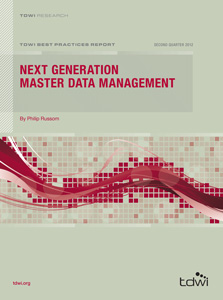
Next Generation Master Data Management: Executive Summary
This TDWI Research report describes the many new best practices, solutions, and tools that have emerged as next generation master data management (MDM). It also helps readers map their options to real-world use cases and develop a strategy for MDM.
- By Philip Russom, Ph.D.
- April 2, 2012
The Current MDM Challenge: Moving to the Next Generation
 Master data management (MDM) is one of the most widely adopted data management disciplines of recent years. That’s because the consensus-driven definitions of business entities and the consistent application of them across an enterprise are critical success factors for important crossfunctional business activities, such as business intelligence (BI), complete views of customers, operational excellence, supply chain optimization, regulatory reporting, compliance, mergers and acquisitions, and treating data as an enterprise asset. Due to these compelling business reasons, many organizations have deployed their first or second generation of MDM solutions. The current challenge is to move on to the next generation.
Master data management (MDM) is one of the most widely adopted data management disciplines of recent years. That’s because the consensus-driven definitions of business entities and the consistent application of them across an enterprise are critical success factors for important crossfunctional business activities, such as business intelligence (BI), complete views of customers, operational excellence, supply chain optimization, regulatory reporting, compliance, mergers and acquisitions, and treating data as an enterprise asset. Due to these compelling business reasons, many organizations have deployed their first or second generation of MDM solutions. The current challenge is to move on to the next generation.
For example, some MDM programs focus on the customer data domain, and they need to move on to other domains, like products, financials, partners, employees, and locations. MDM for a single application (such as enterprise resource planning [ERP] or BI) is a safe and effective start, but the point of MDM is to share common definitions and reference data across multiple, diverse applications. Most MDM hubs support basic functions for the offline aggregation and standardization of reference data, whereas they should also support advanced functions for identity resolution, two-way data synchronization, real-time operation, and approval workflows for newly created master data. In parallel to these generational shifts in users’ practices, vendor products are evolving to support advanced MDM functions, multi-domain MDM applications, and collaborative governance environments.
According to survey respondents, the top reasons for implementing an MDM solution are to enable complete views of key business entities (customers, products, employees, etc.) and to share data broadly but consistently across an enterprise. Other reasons concern the enhancement of BI, operational excellence, and compliance. Respondents also report that MDM is unlikely to succeed without strong sponsorship and governance, and MDM solutions need to scale up and to cope with data quality (DQ) issues, if they are to succeed over time.
“Customer” is, by far, the entity most often defined via MDM. This prominence makes sense, because conventional wisdom says that any effort to better understand or serve customers has some kind of business return that makes the effort worthwhile. Other common MDM entities are (in survey priority order) products, partners, locations, employees, and financials.
MDM maturity is good, in that 61% of organizations surveyed have already deployed MDM solutions, and over one-third practice multi-data-domain MDM today. On the downside, most MDM solutions today are totally or partially homegrown and/or hand coded. But on the upside, homegrown approaches will drop from 45% today to 5% within three years, while dedicated MDM application or tool usage will jump from 12% today to 47%. To achieve generational change, half of organizations anticipate replacing their current MDM platform(s) within five years.
Over the next three years, we can expect the strongest growth among MDM features and functions for real-time, collaboration, data synchronization, tool use, and multistructured data. Good growth is also coming with MDM functions for workflow, analytics, federation, repositories, and event processing. Some MDM options will experience limited growth, because they are saturated (services, governance, quality) or outdated (batch processing and homegrown solutions).
This report helps user organizations understand all that MDM now offers, so they can successfully modernize and build up their best practices in master data management. To that end, it catalogs and discusses new user practices and technical functions for MDM, and it uses survey data to predict which MDM functions will grow most versus those that will decline—all to bring readers up to date so they can make informed decisions about the next generation of their MDM solutions.
DataFlux, IBM, Oracle, SAP, and Talend sponsored the research for this report.
About the Author
Philip Russom, Ph.D., is senior director of TDWI Research for data management and is a well-known figure in data warehousing, integration, and quality, having published over 600 research reports, magazine articles, opinion columns, and speeches over a 20-year period. Before joining TDWI in 2005, Russom was an industry analyst covering data management at Forrester Research and Giga Information Group. He also ran his own business as an independent industry analyst and consultant, was a contributing editor with leading IT magazines, and a product manager at database vendors. His Ph.D. is from Yale. You can reach him by email ([email protected]), on Twitter (twitter.com/prussom), and on LinkedIn (linkedin.com/in/philiprussom).